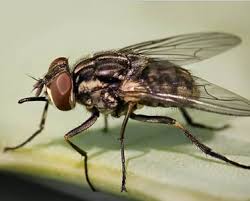Flies you can keep out with screens (and beaded curtains).
A transparent plastic bag with water, hang on the door would also help.
 With a whisk, flytrap, flycatcher (adhesive tape) and carnivorous plants you can catch them or murder.. (Prussian) blue they seem to shun.
With a whisk, flytrap, flycatcher (adhesive tape) and carnivorous plants you can catch them or murder.. (Prussian) blue they seem to shun.
They do not like tansy, lavender, bay, Apple of Peru or shoo-fly plant (Nicandra physalodes), marigold (Tagetes patula), elder and walnut. And hate evaporating vinegar, or a slice of lemon.
The Blandford fly (Simulium posticatum) is a blood-sucking, small (2-3 mm) black fly, named after the English town where they bothered 600 people in 1972. The female is looking for blood before mating. The sting (on the lower legs) is painful and creates swelling, allergic reactions and itching. She also appears in the Lower Countries.
At the black stable fly (Stomoxys calcitrans) you see at the head the palps with which they can viciously stab. She sits with her head up, in contrast to the house fly (Musca domestica), which is as large (6-8 mm), has no stinging mouth parts and does not bite. The black housefly is a microbe taxi. The bacteria species inside the fly remain fairly similar in different countries and environments. Flies from similar environments carry similar microbes communities (and fungi) on their bodies, which means that they can easily ride along. A healthy person does not normally suffer from these lifters.
Zebra stripes painted on a cow halve the number of painful fly bites. The white stripes confuse the motion detectors of a fly so that they approach the cattle at high speed, but cannot delay in time and therefore cannot land (according to a Japanese study).
A zebra is black, with white stripes (where the pigmentation is missing).
The fly agaric or fly amanita (Amanita muscaria) is Europe’s most famous and typical mushroom: dark red hat with white dots.
In the 13th century Albertus Magnus wrote: "He is called fly agaric because he kills flies when he is crushed in milk."
The existing toxins (especially from the red fleece, muscarinic) dissolve in milk and attract flies. In this way it was (only accessible for flies) used in cattle stables as an insecticide.
The toxicity is often exaggerated in the vernacular. Touching will not hurt you. After eating follows excitation: behavioral disorders, euphoria or anger, agitation, confusion, delirium, hallucinations.
Then a deep sleep (sometimes a coma). Nausea, vomiting and diarrhea may also occur.
Usually the body restores within 12 to 24 hours. The treatment consists of fighting the symptoms, there is no antidote.
"You should just be a dayfly, and you just do not have your day." (Fons Janssen)
The fly who don’t want to be slapped finds the safest place on the fly swatter.
